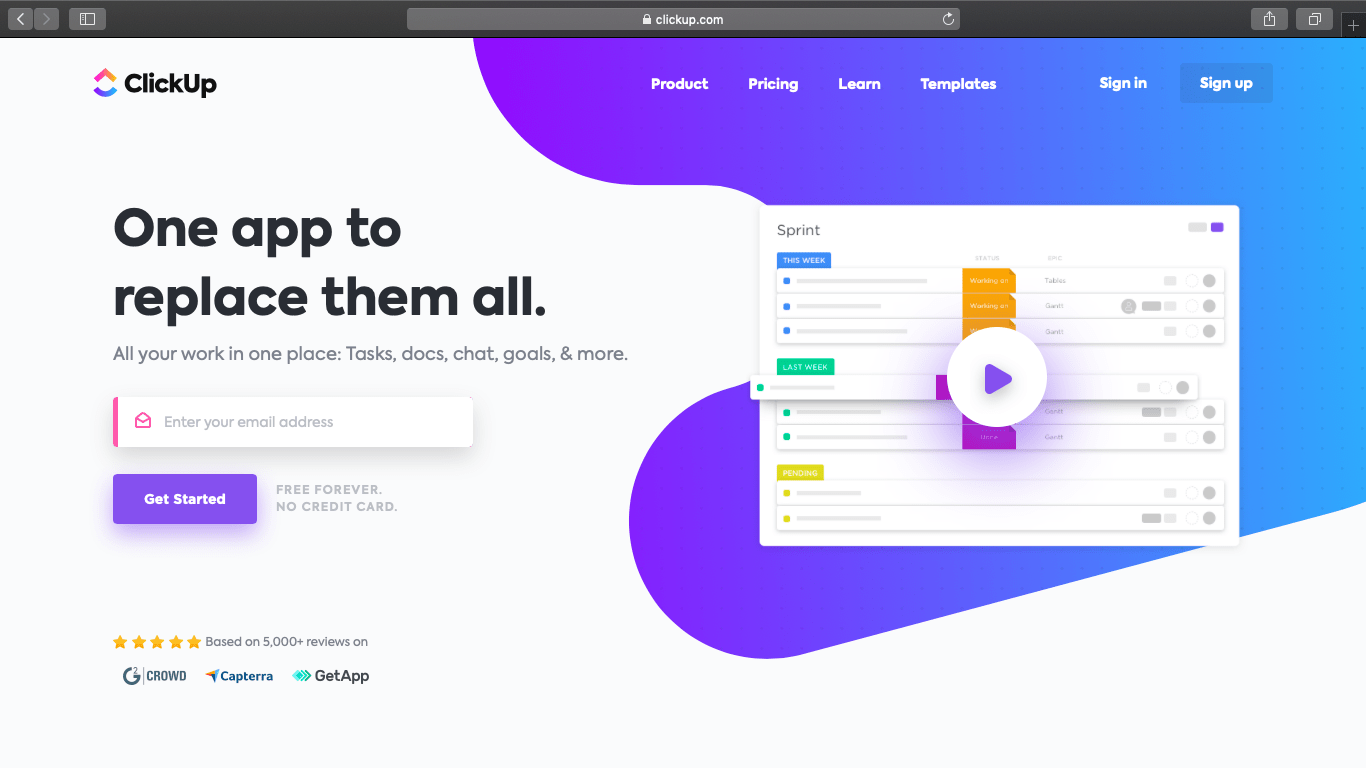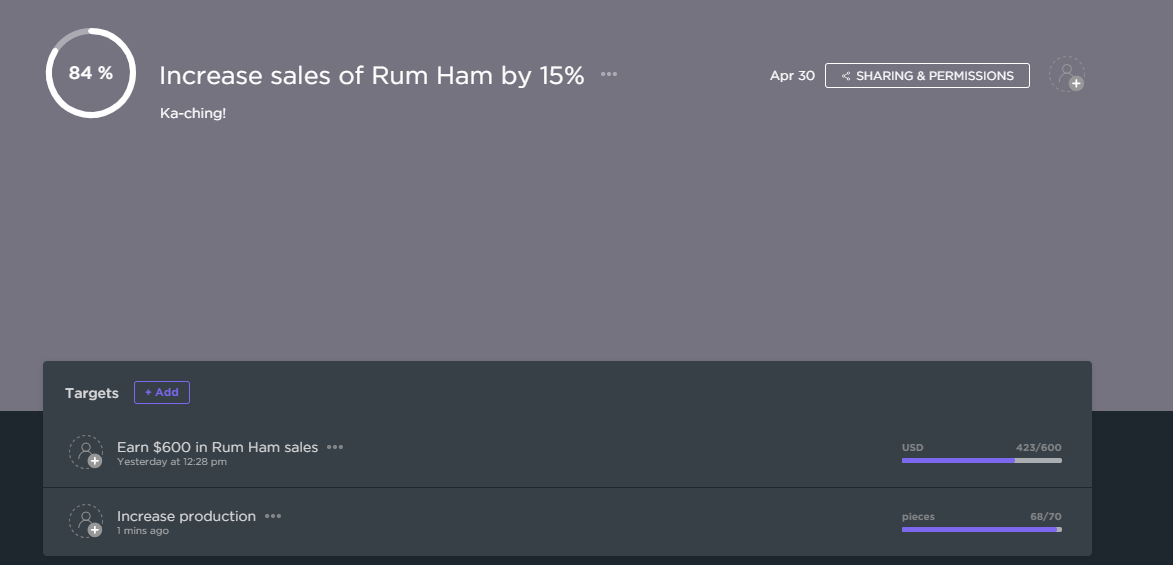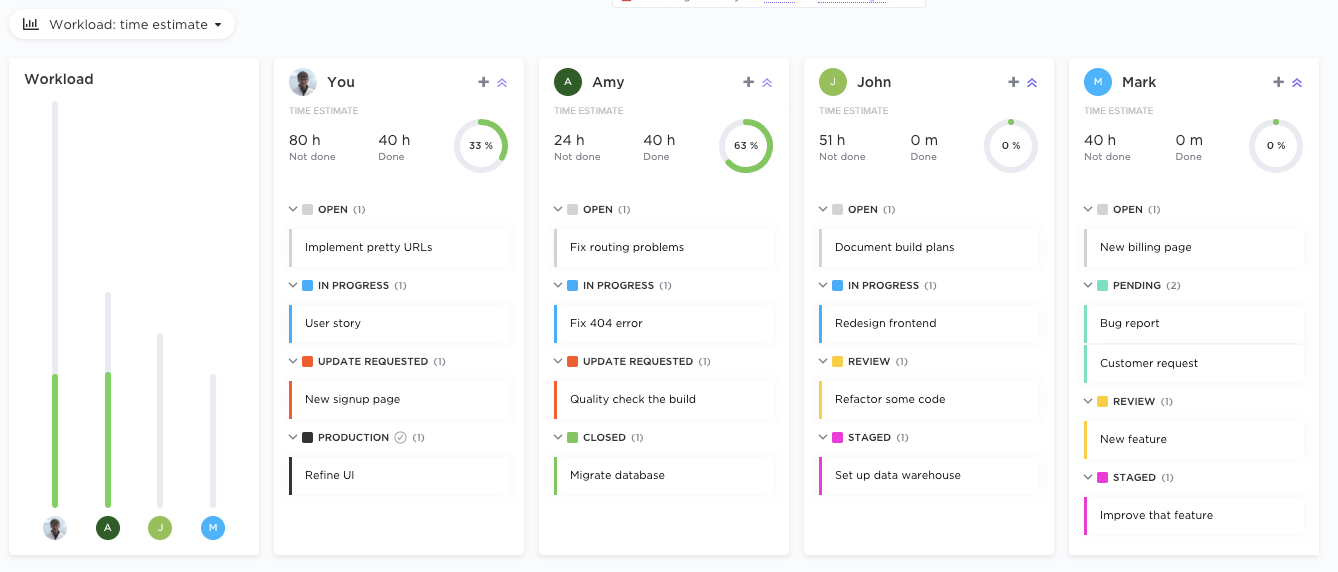مستعد للتعرف على الفرق بين الأهداف _والأهداف؟
قد تكون عمليات تحديد الأهداف والغايات متشابهة، ولكن يجب التعامل مع كل منهما بشكل مختلف.
في هذا المقال، سنساعدك في هذه المقالة على حسم الجدل حول الهدف مقابل الغاية، من خلال تسليط الضوء على الاختلافات بين الاثنين، _وكيف يعملان معًا، و أفضل أداة لمساعدتك في تتبع كليهما!
هيا بنا نبدأ.
ما هي الأهداف؟
الهدف هو النتيجة المرجوة التي ترغب في تحقيقها.
أهداف الشركة هي البوصلة - إعطاء فريقك فكرة عما يحتاجون إلى تحقيقه والاتجاه الذي يجب أن يتجهوا إليه.
وهي في الأساس هي النوايا العامة للشركة ويمكن أن تساعد في توجيه بيان المهمة. فهي تساعدك على التركيز على ما تتطلع إلى تحقيقه.
ومع ذلك، فإن الأهداف الموجهة نحو النتائج تتعامل فقط مع النتائج النهائية - فهي لا تخبرك كيف ستصل إلى هناك.
_هذا لا يعني أن تحديد الأهداف ليس مهمًا!
إن تحديد الأهداف مهم حقًا لأنه يمنح فريقك التركيز على ماذا يطمحون إليه - مما يمنحهم الوضوح بشأن كل شيء، الأمر الذي سيعزز من تحفيزهم وإنتاجيتهم!
المكافأة:_ أهداف ذكية للطلاب
ما هي الأهداف؟
الأهداف تحدد ما يحتاج فريقك إلى القيام به من أجل تحقيق الهدف.
وهي عبارة عن بيانات محددة قابلة للقياس لها هدف محدد يسعى فريقك للوصول إليه.
وبعبارة أخرى، فإنها تغير الأهداف الموجهة نحو النتائج إلى أهداف عملية المنحى بحيث يمكن أن تكون هناك إنجازات قابلة للقياس في الاتجاه الصحيح.
على سبيل المثال:
لنفترض أنك تريد زيادة إيرادات عملك التجاري.
وللقيام بذلك، فإن أحد أهدافك التسويقية هو زيادة عدد العملاء بنسبة 20%.
هنا، هدفك هنا هو زيادة الإيرادات بينما هدفك_ هو زيادة العملاء بنسبة 20%!
الأهداف مقابل الغايات: ما هي الاختلافات الرئيسية؟
يتمثل الفرق الرئيسي بين الأهداف والغايات في أن الأهداف أوسع نطاقًا وتساعد على خلق الرؤية والتوجيه، في حين أن الغايات هي أهداف أكثر تحديدًا وتصف الإجراءات الملموسة لتحقيق نتيجة نهائية.
فيما يلي بعض هذه الاختلافات الرئيسية بين الأهداف والأهداف مفصّلة
1. النطاق
الأهداف:
الأهداف هي بيانات أكثر عمومية نسبيًا، لذا يمكن أن يكون نطاقها واسعًا.
وفي بعض الحالات، ليس من الضروري أن تقتصر حتى على فريق أو مشروع - بل يمكن أن تتبع المنظمة بأكملها أهدافًا واسعة النطاق وموجهة نحو تحقيق النتائج!
على سبيل المثال:
إذا كان الهدف النهائي هو _فقط كسب المزيد من المال، يمكن لجميع أعضاء المنظمة أن يوحدوا جهودهم لتحقيق هذا الهدف.
الأهداف: أهداف المشروع هي أكثر تحديدًا من الأهداف وعادةً ما تشير إلى عملية معينة - مثل المبيعات والتسويق.
على سبيل المثال:
إذا كنا نتحدث عن أهداف المبيعات والتسويق، فيمكن أن يكون لديك أهداف عملية مثل زيادة بنسبة 20% في عدد العملاء المحتملين في مسار المبيعات.
2. الإطار الزمني
الأهداف:
أهداف المنظمة لها إطار زمني أطول من الأهداف.
على سبيل المثال، الإطار الزمني المثالي لأهداف شركة مدرجة على قائمة فورتشن 500 هو من ثلاث إلى خمس سنوات في حين أن المدارس و معاهد التعليم المبكر تفضل استخدام الأهداف السنوية.
الأهداف:
الأهداف الفعالة لها هدف محدد يتم تحديده حول إطار زمني قصير أو متوسط.
على سبيل المثال، يمكن أن تستمر الأهداف قصيرة الأجل الشائعة لفترة زمنية قصيرة مثل الربع المالي . يحتاج فريقك إلى الإسراع في تحقيق أهدافك ضمن هذا الإطار الزمني.
ذات الصلة:_*
_/مرجع/ https://clickup.com/blog/short-term-vs-long-term-goals// الاختلافات بين الأهداف طويلة وقصيرة الأجل* *%/%href/_
إليك جدول مفيد للمقارنة بين الأهداف والغايات.
جدول الفروق بين الأهداف والغايات
| الأهداف | الغايات | |
|---|---|---|
| النطاق | بيانات عامة واسعة النطاق | أهداف ضيقة ومحددة |
| الخصوصية | النتيجة الإجمالية المرجوة | الإجراءات الملموسة |
| القياس | على الأرجح حسب الفصول أو السنوات | على الأرجح حسب اليوم أو الأسبوع أو الشهر |
| الجدول الزمني | المدى الطويل | المدى القصير أو المتوسط |
| الاستراتيجية | مفيدة لتحديد الاتجاه أو الرؤية | مفيدة لتخطيط الخطوات نحو تحقيق نتيجة نهائية |
| العدد | أهداف محدودة لكل فئة عمل | أهداف متعددة لهدف أو عملية واحدة |
الأهداف مقابل الغايات: كيف يعملان معًا معًا؟
إذا كان لديك أهداف ولكن ليس لديك أهداف قابلة للقياس لدعمها - لن تتمكن من الحصول على مذاق النجاح (والزبد)!
إليك كيف يمكن لشركتك استخدام الأهداف والغايات معًا لمساعدتك على تحقيق النجاح:
استخدام الغايات والأهداف معًا - الخطوة 1: حدد الأهداف
يجب أن تتوافق أهداف عملك مع أهداف شركتك بيان المهمة . وهذا يضمن أن تكون أهدافك ذات صلة ومرتبطة بعملائك وموظفيك. وبمجرد تحقيق ذلك، يجب أن يكون فريقك متحمسًا للعمل معًا وتحقيق الهدف معًا
على سبيل المثال
- قد تكون شركة ناشئة تحديد مدى ملاءمة المنتج للسوق (انظر كيف هذاتستخدم شركة ناشئة ClickUp لتتبع نتائج الأداء الجيدة!)
- قد تكون إحدى شركات فورتشن 500 التوسع في سوق جنوب شرق آسيا
لكن الأمر لا ينتهي بـ فقط تحديد مجموعة من الأهداف لعملك.
فبمجرد الانتهاء من تحديد الأهداف، عليك تقسيمها إلى أهداف قابلة للقياس:
استخدام الغايات والأهداف معًا - الخطوة 2: إنشاء أهداف SMART
بعد عملية تحديد الأهداف - تحتاج إلى تحديد الأهداف التي يمكن أن تساعد فريقك على تحقيقها.
ومع ذلك، هناك بعض القواعد التي تحتاج إلى اتباعها أثناء وضع الأهداف.
كل ما عليك فعله هو إنشاء أهداف SMART!
S.M.A.R.T هو اختصار لجعل أهدافك Sمحددة، Mقابلة للتحقيق، Aيمكن تحقيقها، Rذات صلة، Tمحددة زمنيًا.
لا بد أنك سمعت عن الأهداف الذكية ، فلماذا نطلق عليها أهدافًا ذكية؟
الأمر كله يتعلق بالسياق.
نحن نتحدث عن الغايات _والأهداف، وقد ذكرنا أن الغايات هي ما تحتاج إلى القيام به من أجل تحقيق أهدافك. لهذا السبب من المنطقي أن نتحدث عن أهداف SMART بدلاً من ذلك.
دعنا نرى هذه العملية على أرض الواقع:
1. الأهداف المحددة
الهدف المحدد هو زيادة مبيعات "Rum Ham" للعملاء الجدد (قرار مشكوك فيه، لكنه على الأقل محدد!)
2. أهداف قابلة للقياس
يجب عليك أيضًا أن تكون قادرًا على تتبع التقدم المحرز في تحقيق أهدافك ومعالم عملك الرئيسية.
_ لماذا؟
كيف يمكنك التحقق مما إذا كنت على المسار الصحيح أم لا؟
لذا، في حين أن "زيادة مبيعات لحم الخنزير الروم" هدف جيد - إلا أنه لا يوجد مقياس واضح له.
سيكون الهدف القابل للقياس هو زيادة المبيعات للعملاء الجدد بنسبة 200%.
3. الأهداف القابلة للتحقيق
يجب أن يكون هدفك أيضًا مستندًا إلى الواقع.
في حين أنه سيكون من الجيد زيادة المبيعات بنسبة 200%، إلا أنه ليس لديهم ما يكفي من أعضاء الفريق لدفع المنتج.
هنا، الهدف الأكثر قابلية للتحقيق هو: زيادة المبيعات للعملاء الجدد بنسبة 30%.
4. الأهداف ذات الصلة
يجب أن تكون الأهداف الذكية مهمة لمهمة العمل. يجب أن تكون الأهداف مرتبطة دائمًا بشيء يمكن أن يساعد على نمو أعمالهم وتحسين رضا العملاء وما إلى ذلك.
لنفترض أنك شركة SaaS. قد ترغب في التفكير ملياً في تقديم خدمات منجزة لك تتطلب تدخلاً بشرياً. فهذا لا علاقة له بكيفية عمل نماذج نمو البرمجيات كخدمة SaaS، ويعني أنك إما تفتقر إلى ملاءمة المنتج للسوق أو إلى استراتيجية نمو قابلة للتطوير.
5. الأهداف الموقوتة
الأهداف لا يمكن أن تستمر إلى الأبد.
أنت بحاجة إلى تحديد موعد نهائي لها وإلا ستستمر في معالجتها بلا توقف وستفقد هدفك!
لذا فإن الهدف النهائي لـ SMART هو
بحلول أكتوبر 2024، يجب زيادة المبيعات للعملاء الجدد بنسبة 30%.
بهذه الطريقة، مع وجود هدف ذكي، يعرف فريقك بالضبط ما يجب القيام به وكيفية القيام به.
استخدام الغايات والأهداف معًا - الخطوة 3: إنشاء الاستراتيجيات والتكتيكات
بمجرد أن تضع الأهداف القابلة للقياس - يحتاج فريقك إلى معرفة كيفية تحقيق تلك الأهداف وتحقيق أهدافك النهائية.
وهنا يأتي دور استراتيجيتك المستهدفة.
الاستراتيجية المستهدفة هي سلسلة من الخطوات أو المهام التي يجب القيام بها من أجل تحقيق الهدف أو الغاية.
تذكّر، لن تنجح كل استراتيجية تحاول تنفيذها - الأمر متروك لك لتجربة استراتيجيات مختلفة حتى تحقق هدفك في النهاية.
وعندما تحقق عددًا كافيًا من الأهداف، ستتمكن من تحقيق هدفك العام!
كيف تتابع أهدافك وغاياتك ## كيف تتابع أهدافك وغاياتك
بمجرد أن تحدد أهداف وغايات عملك، يجب على فريقك أن يعمل معًا للحصول على النتائج المرجوة.
_ولكن كيف تعرف ما إذا كنت على المسار الصحيح؟
عندما تكون على متن قارب في مياه غير مألوفة، فأنت بحاجة إلى مرشد سياحي لمساعدتك في معرفة أين أنت!
ستساعدك أداة إدارة المشروع مثل ClickUp على تطوير وتتبع أهدافك وغاياتك الموجهة نحو العملية. سيساعدك ذلك على قياس الأداء السابق وإبقاء الجميع على نفس الصفحة.
ما هي انقر فوق ?

ClickUp هي واحدة من أكثر صفحات أدوات إدارة المشاريع عن بُعد الأعلى تقييمًا . يتم استخدامه من قبل أكثر من 200,000 فريق عمل حول العالم، بما في ذلك فرق من الشركات الناشئة والشركات الكبيرة.
يحتوي على جميع الميزات التي تحتاجها لإنشاء وإدارة أهدافك وغاياتك بكل سهولة!
إليك نظرة عن كثب على كيفية القيام بذلك:
أنواع الأهداف في ClickUp
بغض النظر عن نشاطك التجاري أو أهداف عملك، فإن ClickUp سيساعدك في تحقيقها.
إليك بعض أنواع الأهداف الهادفة التي يمكنك إنشاؤها وتتبعها في ClickUp:
- أهداف الفريق
- الأهداف السريعة
- الأهداف الشخصية
- الأهداف الشخصية
1. أهداف الفريق هل تريد من فريقك_ أن يدفعوا أنفسهم ويكونوا أكثر إنتاجية؟
جرّب أهداف فريق ClickUp's Team Goals.
في ClickUp، الأهداف عبارة عن حاويات عالية المستوى يمكن تقسيمها إلى أهداف ملموسة أصغر.
هذه الأهداف قابلة للقياس بسهولة، وعندما تكملها، فإنك ستكمل هدفك أيضًا.
بهذه الطريقة، عند استخدام ClickUp، تكون الأهداف في الأساس هي الغايات التي تساعدك على تحقيق أهدافك!
إليك كيفية إنشاء و إدارة الفريق الأهداف في ClickUp.
الخطوة 1
انقر على زر الكأس الصغير اللطيف داخل ClickUp.

ثم ببساطة أدخل أهدافك في نافذة الهدف التي تنبثق.
على سبيل المثال، قد يكون الهدف النهائي لفريقك هو زيادة المبيعات بنسبة 15%:
الخطوة 2
بعد تحديد الهدف، يمكنك تعيينه لأعضاء فريقك.

الخطوة 3
الآن بعد أن قمت بتعيين الهدف، حان الوقت لإنشاء الأهداف.
في ClickUp، الهدف = الغاية
لذا أضف الأهداف التي ستساعدك على تحقيق أهدافك القابلة للقياس.
وبما أنك تحتاج إلى قياس هذه الأهداف، يمكنك الاختيار من بين مجموعة متنوعة من الوحدات مثل:
- الأرقام: أي قيمة من 0 إلى ما لا نهاية!
- صحيح/خطأ: هل تحقق الشرط أم لم يتحقق؟ هل تحقق الشرط أم لم يتحقق؟
- عملة: أي قيمة من 0 إلى ما لا نهاية: أي مبلغ من المال
- مهام: أي مبلغ من المال: مهمة أو قائمة مهام يجب إكمالها.

بعد تحديد كل هدف، يمكنك الانتقال إلى تعيين كل هدف لأعضاء الفريق المختلفين!
الخطوة 4
الآن، يمكنك البدء في معالجة كل هدف لتحقيق أهدافك وغاياتك القابلة للقياس.
في كل مرة يقترب فيها فريقك من أحد أهدافه أهداف المشروع ، يمكنهم تحديث الأرقام داخل كل هدف من أهداف ClickUp الخاصة بهم.
_وهنا يأتي الجزء الأفضل!
تقوم ClickUp تلقائيًا بحساب النسبة المئوية للتقدم في الهدف تلقائيًا بناءً على الأهداف.
وبهذه الطريقة، كلما قمت أنت أو فريقك بتحديث أحد الأهداف، تقيس أهدافك الإجمالية في الوقت الفعلي. يمكن أن يمنح ذلك أعضاء فريقك دفعة تحفيزية، حتى يتمكنوا من تحقيق المزيد من الأهداف!
ب. الأهداف السريعة
ClickUp هو أيضًا الأداة المثالية إذا كنت تدير فريق تطوير برمجيات رشيق .
_لماذا؟
يمكنك استخدام ClickUp لمراقبة التقدم المحرز في Agile و سكروم سباقات السرعة
_كلا، ليس هذا العدو السريع!
العدو السريع هو فترة زمنية يقوم فيها فريق تطوير البرمجيات بإنشاء نموذج عمل لمنتج ما.
إليك كيفية تتبع أهداف السباق في ClickUp:
- إنشاء هدف
- حدد تاريخ استحقاق لهدفك السريع
- حدد مجموعة من الأهداف التي ستساعدك على تحقيق هدفك السريع
- أضف تلك الأهداف كمهام

والآن، كل ما عليك فعله هو الاستمرار في تحقيق أهدافك، ويمكنك أن ترى تحديث النسبة المئوية لتقدم هدفك السريع في الوقت الحقيقي!
ج. بطاقات الأداء الأسبوعية
تسمح لك معظم أدوات تحديد الأهداف فقط بتتبع أهدافك الخاصة بك وأهدافك.
ومع ذلك، تتيح لك ClickUp تتبع الأهداف الفردية لأعضاء فريقك أيضًا! في ClickUp، يمكن لفريقك إنشاء الأهداف والمهام الأسبوعية التي يحتاجون إلى تحقيقها ومشاركتها مع الفريق.

تساعد بطاقات الأداء الأسبوعية المديرين في الحصول على نظرة عامة على ما يعمل عليه الجميع. يمكنك أيضًا الاطلاع على كيفية مساهمة الجميع في تحقيق الهدف.
وهذا يحفز فريقك على العمل معًا وتحقيق المزيد من الأهداف القابلة للقياس!
ولكن انتظر، بطاقات الأداء ليست الطريقة الوحيدة التي يمكن للمديرين من خلالها مراقبة فريقهم!
يمكنهم استخدام خاصية ClickUp عرض الصندوق و الملفات الشخصية لمعرفة المهام التي يعمل عليها أعضاء الفريق.

د. الأهداف الشخصية
ClickUp ليس فقط لـ الأعمال.
يمكنك استخدام ClickUp لإنشاء أهداف شخصية أيضًا!

يتيح لك ClickUp تخصيص الأذونات لجميع أهدافك وغاياتك. يمكنك اختيار من يمكنه عرض أهدافك أو تعديلها، أو يمكنك الاحتفاظ بها خاصة تماماً.
ملاحظة: يمكنك حتى تخصيص الأذونات لهدف مشروعك أيضًا. بهذه الطريقة، يمكنك تخصيص ما يمكن لبعض أعضاء الفريق أو العملاء القيام به عندما يتعلق الأمر بأهدافك.
E. OKRs حان وقت سؤال اختبار مفاجئ:
ما هو المشترك بين Spotify و Netflix و Amazon؟
_كلا - لا يعني ذلك أن جميعهم مستنزفون للإنتاجية!
جميع الشركات الثلاث تستخدم تقارير الأداء!
الأهداف والنتائج الرئيسية OKRs هي إطار عمل لتحديد الأهداف تستخدمه المؤسسات لتحديد وقياس أهداف الشركة والموظفين. وهي تقسم كل هدف إلى مجموعة من النتائج الرئيسية التي ستساعدك على تحقيق هذا الهدف.
قد يبدو إطار عمل OKR شاقًا، لكنه سهل للغاية.
كل ما تحتاجه هو ClickUp.
ومع ذلك، في مصطلحات OKR الأهداف = الأهداف
لتوضيح أي التباس، راجع هذا الجدول:
| المصطلحات التي تمت مناقشتها حتى الآن في المقال | مصطلحات النقر على المصطلحات | مصطلحات OKR | |
|---|---|---|---|
| أهداف | أهداف | أهداف | أهداف |
| الأهداف | الأهداف | النتائج الرئيسية |
- وبالتالي، عندما تقوم بإعداد أهداف ClickUp، فأنت تقوم بإعداد أهداف OKR الخاصة بك
- وعندما تقوم بإعداد أهداف ClickUp الخاصة بك، فأنت تقوم بإعداد النتائج الرئيسية الخاصة بك

بصرف النظر عن تغيير الاسم، يظل كل شيء كما هو!
بهذه الطريقة، إذا كنت ترغب في اتباع نهج OKR، ما عليك سوى استخدام الخطوات التي أوضحناها في نقطة أهداف الفريق وستكون بخير!
ملاحظة: لا ينبغي أن تكون OKRs الخلط بينها وبين مؤشرات الأداء الرئيسية (مؤشرات الأداء الرئيسية).
تساعدك OKRs على تتبع أهدافك، بينما مؤشرات الأداء تقيس نجاح العملية الجارية.
لكننا لم ننتهي بعد! أساتذة سكروم و مديرو المشاريع الرشيقة يحصلون على الكثير من المخططات المفيدة لتتبع مدى تقدمهم نحو أهدافهم مثل
- مخططات الحرق :: يسلط الضوء على مهام المشروع التي أنجزها فريقك عن بُعد حتى الآن
- مخططات الحرق : يسلط الضوء على حجم العمل المتبقي في المشروع
- مخططات السرعة : يحدد معدل إنجاز فريقك للمهام في المشروع
- / href/ https://clickup.com/blog/cumulative-flow-diagram/// https://clickup.com/blog/cumulative-flow-diagram/* التدفق التراكمي /%href/ : يصور تقدم المشروع على مدار فترة زمنية
حسناً، الآن انتهينا.
الأهداف مقابل الغايات الخلاصة
لننهي النقاش حول الهدف مقابل الغايات هنا.
الأهداف والغايات ليست مصطلحات قابلة للتبديل.
الغايات هي نتيجة تريد تحقيقها ، والغايات تساعدك على معرفة كيفية الوصول إلى هناك.
ومع ذلك، أنت بحاجة إلى كليهما لتحقيق النجاح
إن إنشاء أهداف وغايات ذكية لشركتك يمكن أن يمنح فريقك الدفعة التي يحتاجها!
ولكن تذكر عندما تضع الأهداف والغايات، فأنت بحاجة إلى طريقة لتتبعها أيضًا.
وبما أن أدوات إدارة المشاريع مثل ClickUp تحتوي على الكثير من الميزات لإدارة أهداف عملك وأهدافك الشخصية، فلماذا لا تجربها وجربها مجانًا اليوم! اقرأ المنشورات ذات الصلة:
- أفضل تطبيقات تتبع الأهداف
- أفضل برامج تحديد الأهداف
- أهداف الموارد البشرية

